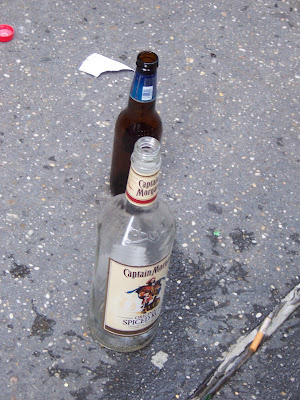
It's tax time again here in America—people say to beware the Ides of March, but I think you're better off bewaring the Ides of April, because that's when the government officially sticks it to you. In other words, Uncle Sam-bam-thank-you-ma'am is here, and you better give him some sugar.
Even more insidious than annual income tax filing, but very much on topic, the powers that be wish to levy a tax on beverages containing sugar, as explained in this article. This tax would cost us New Yorkers 1 penny per ounce of beverage purchased, which means next time you buy an 11.5 ounce can of Jolt Cola, you'll need an extra dime, a penny, and a hay-penny.

This new tariff might be just the financial squeeze that starts me brewing my own root beer in the bathtub. (And that might be just the push I need to break out the "Scrubbing Bubbles" and tackle that weeks-old halo of soap scum.) But even more taxing than the proposed soda levy is this pro-beverage ad that's on every ten minutes.
Notice how when you put the "orange drink" on the checkout immediately following the fresh vegetables it looks almost wholesome? Kind of like how Froot Loops on a table covered with three day's worth of fruit, wheat toast, yogurt and juice is "part of" a complete breakfast?
At last, poor New Yorkers finally have a champion in the person of David Corona, local store-owner and proponent of the idea that, like sliced bread and fresh produce, Kool Aid is a basic necessity. He also appears to stock every kind of ridiculous fruit-themed soda known to the five boroughs.
I like to think that I too provide a modicum of public service, so here's a savvy financial tip for all of those cash-strapped New Yorkers, living paycheck to paycheck and tallying their grocery purchases with a calculator: your obese little children do not need to drink Sunny Delight. What they do need is something that I like to call "actual food," which is sometimes found in the very same establishments. Additionally, if the shoppers Mr. Corona is so ardently advocating for were as sharp as he suggests, they should have realized that if they stop wasting their money on liquid candy, they will have more to spend on cigarettes and lottery tickets.
But getting to the bigger picture: as with any controversy, there is always more to it than what's implied by any one person's oversimplified summary, including my own. I'm not actually advocating for any one side—I find it easier and more satisfying to take things at face value and point out only what seems ridiculous. (I say this not so much to present myself as rational and distanced, but to absolve myself of any responsibility to delve far enough into a subject to really understand what it's about.)
Having glanced over that Reuter's article, I see that there could be a number of issues wrapped up in this tax proposal, including finance, politics, and personal liberties. One person cited who seems to be pretty sure of the facts is American Beverage Association head Larry Young.
"We really don't need people telling us what we eat and drink," said Young, adding that the tax is not meant to battle obesity. "It's for the budget deficits."
Young brings up the plausible claim that the tax isn't about sugar, but about revenue, plain and simple. However I find it amusing that he also couches his argument in ersatz-libertarian rhetoric to give it that obligatory tone of defiance necessary for taking sides on any political issue.
It's become standard that whenever a new tax or regulation is proposed, someone will start braying about how we should be allowed to buy/eat/sleep with/smoke whatever we want, with relevant facts no longer a prerequisite for making alarmist proclamations. As if you won't be "allowed" to walk into a corner store and exchange currency for a plastic bottle of Tropical Fantasy once the price goes up by 12 cents. And as if everything you buy doesn't have a variety of taxes levied on it somewhere along the line of production and shipping and wholesaling and retailing.
And FURTHERMORE (this is where I start waving a finger in the air, slamming my hand on the desk, and generally getting my bow tie all ruffled), people who send their first grade children off to school with a bottle of blue-raspberry "juice" and a bag of Doritos for their breakfast maybe do need to be told what to eat and drink. Or at least, they should have somebody suggest some better choices, you know, in a sympathetic and non-threatening manner, preferably in a city government office with a small couch with comforting throw pillows and some inspirational, positivity-themed posters on the walls.
Obviously we don't want a government that can mandate us to purchase and consume only a select list of products that it deems perfectly healthy (a world without Circus Peanuts is a world I don't want to live in); but I can't take seriously people clucking about our rights to make (stupid) decisions to buy (stupid) products at affordable prices when those clucking people are getting rich by selling shit to poor people. Mmm, such concern for the little people when it comes to taking their money, but what about concern for the fact that you're enabling them to become obese and develop diabetes and heart disease? Mmm indeed. (Sorry, I was eating a Mars Bar.)
Here's my side of an imaginary conversation between me and Larry Young of the American Beverage Whatever:
You want me to acknowledge that people are free to make their own decisions, and that you have a right to sell crap to people if that's what they want? Fine, as long as you acknowledge that you are a greedy fucker. And don't pretend to care about people if you don't thoroughly care about people. . . . What? Yeah sure, I'll have a Dr Pepper. You have any diet?
Hmm. In my imaginary conversation the beverage guy looked a lot like David Corona. You know, I'm not even that sure who it was I was talking to. Anyway, it's just as well, because I may have said some things I'm going to regret.
In the end I can only sit back and hope the soda tax passes, or doesn't pass, and that the little people can still afford their much-needed fruit punch, or that they can't and are the better for it, and that the "Dr Pepper Snapple Group Inc" isn't bankrupted by all the injustice running rampant. Well, that, and also I can see how many Circus Peanuts I can possibly cram into my mouth.
Mmm. Sweeeeet.




















